Vaishnavasthana, Vaishnava-sthana, Vaiṣṇavasthāna: 1 definition
Introduction:
Vaishnavasthana means something in Hinduism, Sanskrit. If you want to know the exact meaning, history, etymology or English translation of this term then check out the descriptions on this page. Add your comment or reference to a book if you want to contribute to this summary article.
The Sanskrit term Vaiṣṇavasthāna can be transliterated into English as Vaisnavasthana or Vaishnavasthana, using the IAST transliteration scheme (?).
Images (photo gallery)
(+4 more images available)
In Hinduism
Natyashastra (theatrics and dramaturgy)
Source: Wisdom Library: Nāṭya-śāstraVaiṣṇavasthāna (वैष्णवस्थान) refers to one of the six “standing-postures” (sthāna), to be used in the release of missiles of all kinds, according to the Nāṭyaśāstra chapter 11.

Natyashastra (नाट्यशास्त्र, nāṭyaśāstra) refers to both the ancient Indian tradition (shastra) of performing arts, (natya—theatrics, drama, dance, music), as well as the name of a Sanskrit work dealing with these subjects. It also teaches the rules for composing Dramatic plays (nataka), construction and performance of Theater, and Poetic works (kavya).
See also (Relevant definitions)
Partial matches: Vaishnava, Sthana.
Starts with: Vaishnavasthanaka.
Full-text: Katisama, Caturashra.
Relevant text
Search found 3 books and stories containing Vaishnavasthana, Vaishnava-sthana, Vaiṣṇavasthāna, Vaiṣṇava-sthāna, Vaisnavasthana, Vaisnava-sthana; (plurals include: Vaishnavasthanas, sthanas, Vaiṣṇavasthānas, sthānas, Vaisnavasthanas). You can also click to the full overview containing English textual excerpts. Below are direct links for the most relevant articles:
Gati in Theory and Practice (by Dr. Sujatha Mohan)
Gati in classical form of Mohiniāṭṭam < [Chapter 4 - Practice of Gati]
Gaits according to characters < [Chapter 2 - Concept and technique of Gati]
Relevant Sthānas and Nyāyas related to perform the Gati < [Chapter 2 - Concept and technique of Gati]
Natyashastra (English) (by Bharata-muni)
Dance Traditions of South India < [January-February 1935]
Dance Traditions of South India < [May-June 1935]





